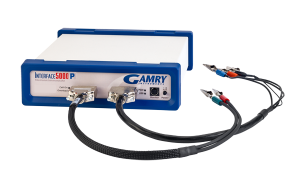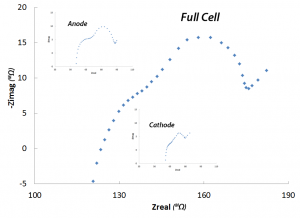 The Gamry Interface 5000 is the latest potentiostat from Gamry Instruments. This full-featured potentiostat/galvanostat is ideally designed for testing batteries, fuel cells and supercapacitors.
The Gamry Interface 5000 is the latest potentiostat from Gamry Instruments. This full-featured potentiostat/galvanostat is ideally designed for testing batteries, fuel cells and supercapacitors.
What makes this potentiostat so unique?
A Dual Electrometer. A second electrometer provides the ability to monitor both half cells in a typical three-electrode setup. With this feature, you can monitor both the anode and cathode in addition to the entire cell in charge/discharge and EIS experiments. The ability to characterize both half cells and the full cell in the same experiment is a time saver.
In addition, the Interface 5000 Potentiostat is available in 2 models. The 5000P is designed for single-cell testing of batteries,  fuel cells or any other energy device.
fuel cells or any other energy device.
The capabilities of this instrument include the following techniques:
- Electrochemical Energy – Includes charge, discharge, cyclic charge-discharge techniques, potentiostatic, galvanostatic, self-discharge, leakage rate, and read cell voltage.
- Galvanostatic EIS (Electrochemical Impedance Spectroscopy) up to 20 kHz.
By purchasing an upgrade to the Interface 5000E, you can have a full-featured potentiostat/Galvanostat including these additional types of techniques:
- Electrochemical Impedance Spectroscopy – Includes experimental scripts for potentiostatic, galvanostatic and hybrid impedance spectroscopy experiments in addition to single frequency. The software even includes a script for EIS simulation.
- Physical Electrochemistry Techniques such as cyclic voltammetry, chronoamperometry, and chronopotentiometry and derivatives of these techniques.
- Pulse Voltammetry Techniques including square wave voltammetry, and associated stripping techniques such as anodic stripping voltammetry.
- DC Corrosion – Run standard DC corrosion tests such as polarization resistance, potentiodynamic, cyclic polarization, and galvanic corrosion in addition to a number of others.
- Electrochemical Signal Analyzer – Designed specifically for the acquisition and analysis of time-dependent electrochemical noise signals. Cell voltage and current are continuously monitored at rates from 0.1 Hz to 1 kHz. A full featured set of analysis tools provides powerful analysis features such as statistical analysis, detrending, impedance spectra, and histogram analysis.
- Electrochemical Frequency Modulation – A non-destructive corrosion rate measurement technique which allows for measurement of the corrosion rate without prior knowledge of the Tafel constants.
- Critical Pitting Temperature – This controls a Gamry Potentiostat, TDC4 Temperature Controller, and associated accessories to automatically measure the Critical Pitting Temperature of a material.
- Electrochemical Noise – A more general form of electrochemical noise testing. It is also an ECM8 Multiplexer compatible electrochemical noise software package.
- eChemAC Toolkit – Our software toolkit that gives full control of a potentiostat capabilities – electrochemical impedance (EIS) measurements and EFM experiments.

